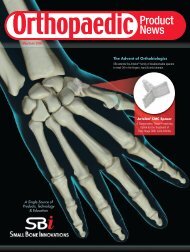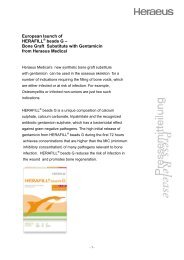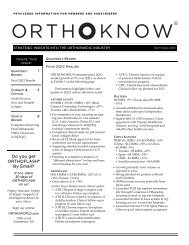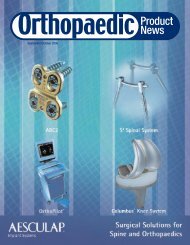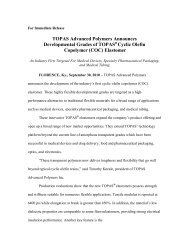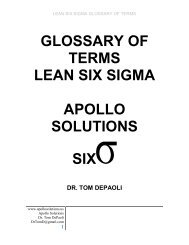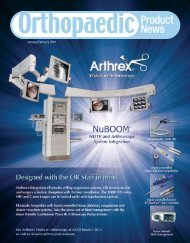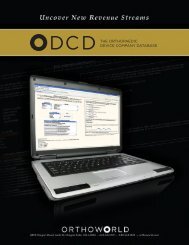Hip & Knee Surgery - Orthoworld
Hip & Knee Surgery - Orthoworld
Hip & Knee Surgery - Orthoworld
You also want an ePaper? Increase the reach of your titles
YUMPU automatically turns print PDFs into web optimized ePapers that Google loves.
SURGEON INTERVIEWcontinued from page 12About that time my son was getting his M.B.A. and needed aproject to work on for one of his classes. I told him about thepatent and he and a few classmates developed a business modelto manufacture the device. After graduation, we started RedynsMedical (Redyns is Snyder backwards) with the short-term goal toproduce the postoperative dressing system. My son Nate and histeam made prototypes, received FDA clearance, manufactured afew thousand units and started selling the product in and aroundsouthern California. The device was named ProWick.After a time, we revisited a number of the companies that hadoriginally turned down the opportunity to develop the technologyand pitched the finished product. Now that they were able tosee and feel the finished device, they became significantly moreinterested in distribution. Ultimately, we decided to partner withArthrex to grow the product’s exposure. Arthrex is currently distributingProWick Shoulder and ProWick <strong>Knee</strong> exclusivelythrough its sales force around the world.Bolstered by this success, the company went on to develop thebacklog of new technology I had stored up in my “top drawer.”OPN: What is Redyns Medical today?SS: Today, Redyns Medical has evolved into a full-service productdesign and development company with a“Now that theywere able to seeand feel the finisheddevice, they becamesignificantly moreinterested indistribution.”mission to empower physician inventors.Our hope is to rekindle the spirit of the“olden days,” before industry grew so bigand the importance of the physicianinventor grew so small.Developing medical devices is significantlymore challenging now than it waswhen I started practice. Back then,arthroscopy was in its infancy and sopractically any idea we had was “new.”The patent landscape was wide open andthere was no real product competitionalready on the market.Today, hundreds of products exist on the market and thousandsof technologies are described in patents. Whereas when I started,all I had to do was come up with a good idea, now I have to makesure it is not already patented, see if it fits within an industry partner’sproduct portfolio and ensure the finished product makessense from an economic perspective, since reimbursements are solow. Now, we actually need to vet ideas before jumping straightinto development. I quickly realized that with all the time I devoteto my practice that I would need help with product development.Redyns Medical is very good at helping those physician inventorswho wish to remain involved in the product developmentprocess maximize the effectiveness of their efforts. When a physicianinventor comes to Redyns Medical with an idea for a newproduct or surgical technique, we will help him or her evaluate thestrengths and weaknesses of the concept before significant capital isinvested into the development effort. Redyns will consider theintellectual property position, engineering feasibility, product costprofile and potential clinical acceptance of the finished product andprovide the physician inventor a better understanding of the valueof his idea. If the concept has potential, Redyns will offer the physicianinventor a variety of product development options – again, allaimed at keeping the physician inventor in control of the process.Typically, if an idea shows promise, Redyns ends up partneringwith the physician inventor, thereby aligning both parties’ interestsin maximizing the return on investment. The physician inventor isable to invest as much or as little of his own money into the effortand is encouraged to be involved in creating the design requirements,testing prototypes and refining the new surgical techniqueis cadaver labs. Once the technology is designed, developed andtested, Redyns will leverage its industry contacts to identify interestedparties. By having multiple parties involved, the physicianinventor can receive a fair market value on his idea. If, for example,the physician were to work directly with one company, thephysician inventor would receive that one company’s estimate ofthe value of the device, which is oftentimes less than optimal.Redyns Medical’s Physician Services Division was recentlylaunched to help educate physicians on the new product developmentprocess. To this end, I sponsored an instructional coursetitled “Medical Device Development: Protecting andCommercializing Your New Product Ideas” at the ArthroscopyAssociation of North America (AANA) last spring. Joining meon the panel was a patent attorney as well as a co-founder ofRedyns Medical, George Rohlinger. Together, we provided avariety of perspectives on the product development effort.Given the strong, positive reviews from our first course, wehave been invited to host another instructional course at the 2010annual AANA meeting, titled “Empowering the Physician-Inventor.” (The course will address the intricacies of the productdevelopment process, from the napkin sketch to the OR, frominvestment consideration to royalty negotiations.Learn which ideas are primed forsurgical and commercial success and how afull-time physician can get new productideas developed and working.)OPN: What advice do you have for surgeonswho are contemplate developing their own ideasinto products?SS: As far as we’ve come, there’s still a longway to go in developing medical products.When you get into the OR, always think toyourself, “How can I make my job easier?”The litmus test to tell if product development is necessary is tosimply recognize when you are having difficulty with something.I guarantee you, if you’re struggling with a technique or adevice; someone else is struggling as well. Ask yourself, “Whatwould make this easier for me?” Then think through the particulars.Imagine using your new device. What steps would berequired, and in what order? What incisions would you make,and what tools would you need? How is the technique currentlydone, and what are the alternatives? At the end of the day, youmust be the product’s champion–you must believe the idea willwork.As a general guideline, a new technology should enable acommunity-based surgeon to perform a given procedure faster,simpler, safer or cheaper than the way it is currently done. Themore of these adjectives that apply to your idea, the more successfulit is likely to be. By far, physicians are the most qualifiedpeople to invent new products. We are on the front line of thehealth care delivery system. We know better than anyone elsewhat works and what doesn’t.All you need is the idea; there are resources to help you withthe rest. Good luck!Interested parties may contact Dr. Snyder at info@redynsmedical.com.November/December 2009 • ORTHOPAEDIC PRODUCT NEWS 13



